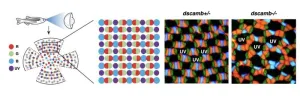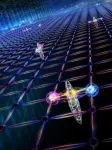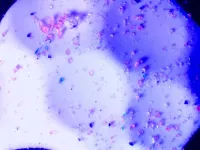(Press-News.org) The findings come from the most comprehensive computer model of brain metabolism to date, which incorporates more than 16,800 biochemical interactions between proteins and chemicals across brain cells, supporting cells, and the blood.
Scientists can now use this open-source model to find ways to prevent age-related diseases, such as dementia.“This study provides an x-ray view into the battery that powers the brain,” said Henry Markram, Professor of Neuroscience at École Polytechnique Fédérale de Lausanne (EPFL), Switzerland, the senior author of the study. “We can now track how the energy system of the brain ages at the molecular level.”
Youthful resilience
The detailed simulation - an analysis of complex interactions between neuronal activity, metabolism, and blood flow – is based on data from human and rodent brains. It provides a glimpse into how brain metabolism breaks down with age and impairs its function, as well as identifying actionable potential ways to restore youthful resilience. We place heavy demands on our brain’s neurons to navigate our everyday lives. This requires a lot of energy and support, which comes from the blood supply and supporting ‘glial’ cells called astrocytes.
To understand the impact of aging on the brain’s metabolism, the team included these elements in their model, which they used to compare the metabolic states of young and aged brains. In all, they calculated the impact of age-related changes on 16,800 interactions between proteins and chemicals across neurons, glia, and the blood. The model revealed that changes in the amounts of certain molecules can have complex knock-on effects, affecting many different metabolic reactions at once. This meant the cells were more vulnerable to damage as they were less able to adapt and recover.
It also highlighted potential drug targets, as well as the potential benefit of supplementing with nicotinamide adenine dinucleotide (NAD) - a molecule that plays a vital role in the brain’s energy supply. NAD-boosting supplements have been previously studied as a potential healthy aging therapy.
Dr Polina Shichkova, the lead author of the Frontiers in Science study, said: “We were surprised by the interdependencies of molecular reactions, tight regulation, and signaling within this system. We showed how the fragility of brain metabolism results from the collapse of many metabolic pathways, not just one, a finding that calls for multiple target therapies.”
A discovery beyond lifestyle factors
The discovery allowed the team to understand the complex molecular mechanisms that determine the robustness, flexibility, and adaptability of the aging brain. By altering the amounts of key chemicals, the researchers found that the aged cells could be restored back to their youthful activity and resilience.
“Our findings go beyond what we already knew about these lifestyle factors,” said Shichkova. “Our model offers a detailed molecular mechanism of these practices, which will help guide researchers to develop more precise or effective interventions.”
The researchers also used the model to identify possible drug targets that could restore resilience to brain cells. They identified a protein called estrogen-related receptor alpha (ESRRA), which is connected to the predicted age-related decline. This finding could lead to further research into developing effective treatments to support aging neurons.
“While there are usually many steps between a computational model’s predictions and practical guidance for people, some of the suggestions of our model include already approved supplements, dietary changes, or lifestyle habits,” said Shichkova.
A tool for further research
The researchers built the model using publicly available data detailing the gene activity of brain cells in humans and mice. When they compared its results to experimental data not used for training, the model accurately predicted changes in biochemical activity in neurons with age. This verified its usefulness as a research tool and the value of its findings.
Shichkova said: “This modeling approach was needed due to the complexity of the system, which cannot be easily studied experimentally. While the model was built from experimental data, the simulation’s predictions of the behavior of the molecular network will in turn guide further biological research.”
The study was part of the Blue Brain Project, which aimed to develop simulations and reconstructions of the mouse brain. The model will be available on the Open Brain Platform hosted by the Open Brain Institute, allowing neuroscientists to run simulations based on the research.
The team hopes this will help accelerate research into age-related neurodegenerative diseases, such as dementia. Energy metabolism is a potential root cause of such conditions, so further research on this, as well as validating the findings in human subjects, might help find new ways to boost the brain’s defenses.
This study was supported by funding to the Blue Brain Project, a research center of the École Polytechnique Fédérale de Lausanne, from the Swiss government’s Eidgenössische Technische Hochschule (ETH) Board of the Swiss Federal Institutes of Technology.
END
Most in-depth simulation of brain metabolism yet reveals new targets for future dementia treatments
A new open-source model of brain metabolism – the most complex ever generated – has shown how altering key chemicals could restore aged cells to their youthful activity and resilience.
2025-03-25
ELSE PRESS RELEASES FROM THIS DATE:
USF study: Smartphones may benefit kids, but public social media use poses risks
2025-03-25
A full slide deck of findings is available at the Box link here
TAMPA, Fla. (March 18, 2025) – A groundbreaking new study of young people’s digital media use has revealed surprising results, including evidence that smartphone ownership may actually benefit children.
The study also suggests a link between social media posting and various negative outcomes, as well as data connecting cyberbullying to depression, anger and signs of dependence on digital media.
The Life in Media Survey, led by a team of researchers at the University of South Florida in collaboration with The Harris Poll, conducted a survey of ...
Study shows how retinal cells know when to keep their distance
2025-03-25
In vertebrate retinas, specialized photoreceptors responsible for color vision (cone cells) arrange themselves in patterns known as the “cone mosaic”. Researchers at the Okinawa Institute of Science and Technology (OIST) have discovered that a protein called Dscamb acts as a "self-avoidance enforcer" for color-detecting cells in the retinas of zebrafish, ensuring they maintain perfect spacing for optimal vision. Their findings have been published in Nature Communications.
Solving a mystery in vision science
Vertebrate retinas contain photoreceptor cells that convert light into neural signals. These photoreceptors come in two main types: rods, which function ...
New type of quantum computer studies the dance of elementary particles
2025-03-25
The standard model of particle physics is our best theory of the elementary particles and forces that make up our world: particles and antiparticles, such as electrons and positrons, are described as quantum fields. They interact through other force-fields, such as the electromagnetic force that binds charged particles.
To understand the behaviour of these quantum fields and with that our universe, researchers perform complex computer simulations of quantum field theories. Unfortunately, many of these calculations are too complicated for even our best supercomputers and pose great challenges for quantum computers as well, leaving many pressing ...
AI can help doctors give intravenous nutrition to preemies, Stanford Medicine study finds
2025-03-25
Artificial intelligence can improve intravenous nutrition for premature babies, a Stanford Medicine study has shown. The study, which will publish March 25 in Nature Medicine, is among the first to demonstrate how an AI algorithm can enable doctors to make better clinical decisions for sick newborns.
The algorithm uses information in preemies’ electronic medical records to predict which nutrients they need and in what quantities. The AI tool was trained on data from almost 80,000 past prescriptions for intravenous nutrition, which was linked to information about how the tiny patients fared.
Using AI to help prescribe IV nutrition could reduce medical errors, ...
New study uncovers key pathways in hydronium and hydroxide ion neutralization
2025-03-25
A new study provides fresh insight into traditional acid-base chemistry by revealing that the mutual neutralization of isolated hydronium (H₃O⁺) and hydroxide (OH⁻) ions is driven by electron transfer rather than the proton transfer that is expected in bulk liquid water. Using deuterated water ions and advanced 3D coincidence imaging of the neutral products, researchers found two electron-transfer mechanisms that produce hydroxyl radicals (OH), which are crucial in atmospheric chemistry. These findings reshape our understanding ...
ASM and IUMS unveil global framework to implement microbial climate solutions
2025-03-25
Washington, D.C.—As climate change continues to accelerate at an alarming pace, innovative and scalable solutions are more critical than ever. This week, the American Society for Microbiology (ASM) and the International Union for Microbiological Societies (IUMS) released Microbial Solutions for Climate Change, a report developed by their scientific advisory group (SAG) of global experts. The report outlines innovative microbial technologies that can significantly contribute to climate change mitigation and underscores the urgent need for coordinated global action across nations ...
‘Low-sugar’ vaccine can provide broad immunity against coronavirus variants
2025-03-25
SAN DIEGO, March 25, 2025 — Sugar coatings aren’t only for candies; they also help viruses, like the ones that cause COVID-19, hide from their hosts’ immune system. Now, researchers have developed a universal vaccine that targets coronaviruses and the sugars that they use as cover. As demonstrated in animal studies, the vaccine removed sugar molecules from an area of a coronavirus spike protein that rarely mutates and created effective and plentiful antibodies to inactivate the virus.
Chi-Huey Wong, a chemistry professor ...
Chewing gum can shed microplastics into saliva, pilot study finds
2025-03-25
SAN DIEGO, March 25, 2025 — Plastic is everywhere. And many products we use in everyday life, such as cutting boards, clothes and cleaning sponges, can expose people to tiny, micrometer-wide plastic particles called microplastics. Now, chewing gum could be added to the list. In a pilot study, researchers found that chewing gum can release hundreds to thousands of microplastics per piece into saliva and potentially be ingested.
The researchers will present their results at the spring meeting of the American Chemical ...
Fluorescent caves could explain how life persists in extraterrestrial environments
2025-03-25
SAN DIEGO, March 25, 2025 — Deep below Earth’s surface, rock and mineral formations lay hidden with a secret brilliance. Under a black light, the chemicals fossilized within shine in brilliant hues of pink, blue and green. Scientists are using these fluorescent features to understand how the caves formed and how life is supported in extreme environments, which may reveal how life could persist in faraway places, like Jupiter’s icy moon Europa.
The researchers will present their results at the spring meeting of the American Chemical Society (ACS). ACS Spring 2025 is being held March 23-27; it features about 12,000 presentations on ...
Hydrophilic coating makes for unflappable golf balls
2025-03-25
SAN DIEGO, March 25, 2025 — The upcoming U.S. Open has professional golfers and spectators looking forward to getting on the green. But the grass’ condition, regardless of a player’s skill, can drastically skew the chances of a winning putt. Now, scientists can slow the roll of a golf ball on a lightning-fast, dry course and speed it up on a sluggish, wet course thanks to a coating that soaks up water molecules without interfering with the ball’s aerodynamics.
Thomas J. Kennedy III, owner of Chemical Innovative Solutions Inc., will present his results at the spring meeting of the American Chemical ...
LAST 30 PRESS RELEASES:
New expert guidance urges caution before surgery for patients with treatment-resistant constipation
Solar hydrogen can now be produced efficiently without the scarce metal platinum
Sleeping in on weekends may help boost teens’ mental health
Study: Teens use cellphones for an hour a day at school
After more than two years of war, Palestinian children are hungry, denied education and “like the living dead”
The untold story of life with Prader-Willi syndrome - according to the siblings who live it
How the parasite that ‘gave up sex’ found more hosts – and why its victory won’t last
When is it time to jump? The boiling frog problem of AI use in physics education
Twitter data reveals partisan divide in understanding why pollen season's getting worse
AI is quick but risky for updating old software
Revolutionizing biosecurity: new multi-omics framework to transform invasive species management
From ancient herb to modern medicine: new review unveils the multi-targeted healing potential of Borago officinalis
Building a global scientific community: Biological Diversity Journal announces dual recruitment of Editorial Board and Youth Editorial Board members
Microbes that break down antibiotics help protect ecosystems under drug pollution
Smart biochar that remembers pollutants offers a new way to clean water and recycle biomass
Rice genes matter more than domestication in shaping plant microbiomes
Ticking time bomb: Some farmers report as many as 70 tick encounters over a 6-month period
Turning garden and crop waste into plastics
Scientists discover ‘platypus galaxies’ in the early universe
Seeing thyroid cancer in a new light: when AI meets label-free imaging in the operating room
Neutrophil-to-lymphocyte ratio may aid risk stratification in depressive disorder
2026 Seismological Society of America Annual Meeting
AI-powered ECG analysis offers promising path for early detection of chronic obstructive pulmonary disease, says Mount Sinai researchers
GIMM uncovers flaws in lab-grown heart cells and paves the way for improved treatments
Cracking the evolutionary code of sleep
Medications could help the aging brain cope with surgery, memory impairment
Back pain linked to worse sleep years later in men over 65, according to study
CDC urges ‘shared decision-making’ on some childhood vaccines; many unclear about what that means
New research finds that an ‘equal treatment’ approach to economic opportunity advertising can backfire
Researchers create shape-shifting, self-navigating microparticles
[Press-News.org] Most in-depth simulation of brain metabolism yet reveals new targets for future dementia treatmentsA new open-source model of brain metabolism – the most complex ever generated – has shown how altering key chemicals could restore aged cells to their youthful activity and resilience.






